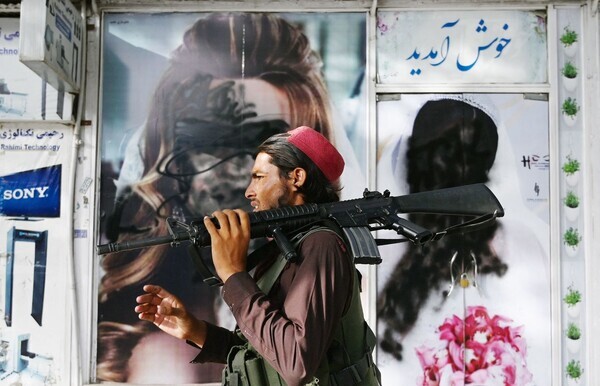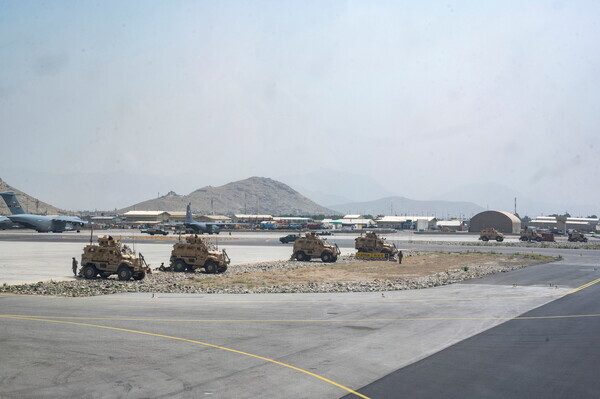hankyoreh
Links to other country sites 다른 나라 사이트 링크
[Column] Accept Afghanistan’s past, its present reality: the Taliban’s return to power

After going on for two decades, the war in Afghanistan finally ended with a defeat for the US.
The Taliban captured the capital city of Kabul and declared victory on Aug. 15. “The war is over,” they announced. The following day’s images showed fear and chaos as Afghan people crowded into the international airport in Kabul hoping to escape.
All of this happened within three months of the US beginning its pullout on May 3. What happened over the years in Afghanistan that enabled the Taliban to return to power in this way?
The war in Afghanistan was the longest in US history. Over 2,448 US troop lives were lost over the 20-year period, and over US$1 trillion was spent on waging the war.
US President Joe Biden insisted that the US had not failed in its war in Afghanistan and that the withdrawal of forces was a decision made in the national interest. But it seems impossible to deny that the war did indeed end in failure.
So why did the US fail? To begin with, the aims and intentions behind the war were not just.
The reason for the US attack was the Taliban administration’s refusal of a demand to turn over Osama bin Laden and al-Qaeda members responsible for the 9/11 terrorist attacks.
There is no justification for attacking someone for their refusal to turn someone over, and there is no evidence to indicate that the Taliban and al-Qaeda shared information or cooperated in connection with 9/11. It was also a violation of international law to attack without UN approval.
The objective behind the US’ war was to set up a pro-US administration. To bring down the Taliban regime, it allied itself with the Northern Alliance, an anti-Taliban coalition.
The Northern Alliance is connected with the Islamic Republic of Afghanistan, which was formed in December 1992 after the toppling of Mohammad Najibullah’s regime in the wake of the Soviet Union’s 1989 withdrawal.
Seven mujahideen groups that had resisted the Soviets banded together to elect Burhanuddin Rabbani as president, but a civil war ensued between Rabbani’s allies and others who opposed him. In 1996, the Taliban occupied Kabul and the Northern Alliance forces moved to the northern part of the country.

The US actively supported the Northern Alliance as a way of bringing down the Taliban regime through the efforts of Afghans. In effect, the Northern Alliance played an instrumental role in unseating the Taliban.
But after the Taliban regime collapsed, the US ignored the Northern Alliance and nominated Hamid Karzai as leader of the provisional government. Karzai had worked since 1996 as an advisor and lobbyist for the US energy company Unocal in negotiations between the Taliban and the Central Asia Gas Pipeline (CentGas) consortium.
After a period at the head of the transitional government, Karzai was elected president, a position he held from 2004 to 2014. The CentGas consortium — formed in August 1996 by Unocal, Delta Oil (Saudi Arabia), Gazprom (Russia), and Turkmengaz (Turkmenistan) — reached an agreement on the construction of a pipeline.
Unocal reached a three-way agreement with Turkmenistan and Pakistan in May 1997. The following September, Turkmenistan and Pakistan announced that they had agreed to provide the Taliban with a 15% share of transit fees. The Taliban objected strongly, expressing their opposition to the project.
So, the real aim of the US may have been to establish a pro-US government in Afghanistan so that it could assume control of petroleum and natural gas in Central Asia.
Misguided national-building campaignUS nation-building efforts in Afghanistan were also misguided in their aims and approach. Washington thought all the problems would be solved once a strong pro-US central government was in place in Kabul. It was mistaken.
Since the Northern Alliance centered around minority ethnic groups, the US argued that the central government needed to be made up of majority Pashtuns (42–45%). Afghanistan is a multiethnic country, its population consisting not only of Pashtuns but also Tajiks (25–27%), Hazaras (8–9%), Uzbeks (8–9%), Turkmens (3%), and Baloches (2%).
The Northern Alliance centered around Tajiks, Hazaras, and Uzbeks. But the Pashtun leaders, Karzai and his successor Ashraf Ghani (2014–2021) lacked both legitimacy and a support base. They became synonymous with corruption and incompetence; Afghans referred to them as the “mayors of Kabul.”
The pro-US central government did not exist to serve the Afghan public. Its attention was focused purely on US interests and regime continuity. The interest of the US was based on whether the administration was pro-US or not.
The Afghan public became increasingly hostile toward the pro-US central government and its reliance on non-Muslim outsiders. Meanwhile, the US forces’ oppressive and disrespectful policies and attitude resulted in them being seen not as saviors from the Taliban but yet another group of occupying forces. Anti-US sentiment grew further as civilians were injured and killed in ongoing US airstrikes.
In May 2009, around 150 people were killed in an errant US strike in the western province of Farah. An anti-US movement intensified in the provinces and rural areas, and as various ethnic nationalists and Islamists banded around the traditional Taliban, “new Taliban” emerged.
The US war in Afghanistan began, continued, and ended in error. The US might win battles, but it could never win the war. It is impossible to govern or suppress another country or people by force.
In that sense, it’s important not to start the wrong wars in the first place, but it’s also essential to have an exit strategy for ending things the right way.
Politically, Central Asia has been in a tumult since the Taliban regained power, and an intense diplomatic war is expected to ensue in neighboring countries.
On the surface, China and Russia welcome a US-free Afghanistan. Internally, their feelings are more mixed. That’s because Washington’s global strategy has the aim of beefing up policies to rein Beijing in.
China and Russia are also concerned about the effects future developments in Afghanistan will have on them. Unlike the Western powers, they’ve decided to keep their embassies in Afghanistan in place in a bid to improve ties with the Taliban.
Russia has memories of its experience when it invaded Afghanistan in 1979 (as the Soviet Union), only to meet with failure. Ostensibly, the reason for the Soviet invasion was to protect the pro-Moscow People’s Democratic Party of Afghanistan administration. In reality, it was seeking to block the spread of Islamism to the Islamic countries of Central Asia in the wake of Iran’s Islamic Revolution.
At the time, the Soviets committed the policy misstep of deeming the popular rebellion in Afghanistan to be nothing more than tribal conflict. It fell into the Afghan quagmire, which would in turn become one of the factors in the Soviet Union’s collapse.
China has been proceeding cautiously to avoid following in the Soviet Union’s footsteps.
China, which shares a 76-kilometer border with Afghanistan, is concerned that the Taliban might support the East Turkestan Islamic Movement, which calls for the independence of the Xinjiang Uyghur Autonomous Region, in western China. China seeks to maintain friendly relations with the Taliban under the pretext of providing economic support.
Turkey and Iran have also kept open their embassies in Kabul, though their respective positions and circumstances are quite different.
Turkey sent a positive message of welcome to the Taliban and expressed its willingness to sit down with all factions as it seeks to expand its influence in Afghanistan.
Iran gloated that the situation in Afghanistan represents a military defeat for the US and promised to help Afghanistan recover and regain stability, but it seems anxious about the Taliban’s return to power. As the national sponsor of Shia Islam, Iran has troubled relations with the Taliban, who regard Shia as a heresy and who have massacred large numbers of the Hazara people, who are Shiites.
What will the future of Afghanistan be now that it’s back under the control of the Taliban? There are two main options facing the Taliban: retaining the Islamic Republic or restoring the Islamic Emirate.
The Taliban have referred to the country as the Islamic Emirate of Afghanistan at official events, symbolizing a return to the past. But the Taliban may also set up an open government with various factions taking part in the cabinet in order to gain the international community’s support for rebuilding the country.
When the Taliban were last in power, they adopted shocking policies that aroused fear and concern in the international community — policies such as repression of women, banning photography as a form of “idol worship,” and destroying the Bamiyan Buddhas, a UNESCO World Heritage Site.
But various countries’ stance toward the Taliban depended on their own national interests. Saudi Arabia, the UAE, and Pakistan gave the Taliban official recognition, while the US stayed silent, claiming it had found nothing objectionable about the Taliban’s application of Sharia law.
Today, the international community needs to take a unified stance on the situation in Afghanistan if it wants the resulting government to be open and inclusive.
The reality of the situation in Afghanistan isn’t easy to comprehend, especially for South Koreans, who dealt with the trauma of a group of missionaries being abducted by the Taliban in 2007.
I’m not an Islamist, nor do I support the Taliban’s Islamic fundamentalism. Nevertheless, we need to understand and accept Afghanistan’s past and its present reality: namely, the Taliban’s return to power.
Afghanistan is often called the “graveyard of empires,” a term that testifies to its tragic history of endless conflict and invasion by foreign powers. That tragedy gave birth to religious dogmatism and a culture of fierce resistance to foreign powers.
But lest we forget, the Afghans are people, too. Their culture and history may be different from ours, but they’re still human beings.
By Yu Dal-seung, professor of Middle Eastern Studies at Hankuk University of Foreign Studie
Please direct comments or questions to [english@hani.co.kr]

Editorial・opinion
![[Column] Season 2 of special prosecutor probe may be coming to Korea soon [Column] Season 2 of special prosecutor probe may be coming to Korea soon](https://flexible.img.hani.co.kr/flexible/normal/500/300/imgdb/original/2024/0426/3317141030699447.jpg) [Column] Season 2 of special prosecutor probe may be coming to Korea soon
[Column] Season 2 of special prosecutor probe may be coming to Korea soon![[Column] Park Geun-hye déjà vu in Yoon Suk-yeol [Column] Park Geun-hye déjà vu in Yoon Suk-yeol](https://flexible.img.hani.co.kr/flexible/normal/500/300/imgdb/original/2024/0424/651713945113788.jpg) [Column] Park Geun-hye déjà vu in Yoon Suk-yeol
[Column] Park Geun-hye déjà vu in Yoon Suk-yeol- [Editorial] New weight of N. Korea’s nuclear threats makes dialogue all the more urgent
- [Guest essay] The real reason Korea’s new right wants to dub Rhee a founding father
- [Column] ‘Choson’: Is it time we start referring to N. Korea in its own terms?
- [Editorial] Japan’s rewriting of history with Korea has gone too far
- [Column] The president’s questionable capacity for dialogue
- [Column] Are chaebol firms just pizza pies for families to divvy up as they please?
- [Column] Has Korea, too, crossed the Rubicon on China?
- [Correspondent’s column] In Japan’s alliance with US, echoes of its past alliances with UK
Most viewed articles
- 11 in 5 unwed Korean women want child-free life, study shows
- 2‘We must say no’: Seoul defense chief on Korean, USFK involvement in hypothetical Taiwan crisis
- 3AI is catching up with humans at a ‘shocking’ rate
- 4[Column] Can we finally put to bed the theory that Sewol ferry crashed into a submarine?
- 5[Editorial] Yoon cries wolf of political attacks amid criticism over Tokyo summit
- 6The dream K-drama boyfriend stealing hearts and screens in Japan
- 7[Photo] “Comfort woman” survivor calls on president to fulfill promises
- 8[Editorial] Was justice served in acquittal of Samsung’s Lee Jae-yong?
- 9[Column] Has Korea, too, crossed the Rubicon on China?
- 10Doubts remain over whether Yoon will get his money out of trip to Japan